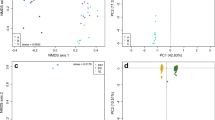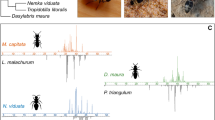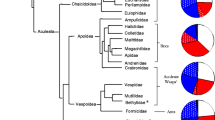Abstract
In social insects, chemical communication is the main communication mode among colony members, which use the blends of cuticular hydrocarbons as recognition cues to discriminate between nestmates and non-nestmates and to prevent the exploitation of their nest resources by aliens. The aim of this study was to assess the variation of nestmate recognition cues in the ant Ectatomma ruidum, a species complex with a considerably conserved morphology and one of the few ant species where intraspecific thievery, a form of cleptoparasitism, has been reported. We analyzed the cuticular hydrocarbon profiles of ants collected from a number of geographically separated populations and examined DNA sequence data to assess their species identity. We focused on one species of the complex, E. ruidum sp. 3–4, whose species delineation remains controversial. We documented that several quantitative and qualitative traits of the cuticular hydrocarbon profiles varied significantly between populations, indicating that this species harbors more cuticular chemical phenotypic diversity than expected within a single species. In particular, there was a striking divergence among populations in the proportion of methylalkanes, alkenes, alkadienes and odd-chain components, which likely play a major role in nestmate/non-nestmate discrimination, a process which might have been crucial in these cleptobiotic ants. Further investigations are needed to test the hypothesis that biotic pressures, such as the need to discriminate conspecific intruders and limit thievery, could have played an important role in promoting the evolutionary divergence between populations in this ant species complex.





Similar content being viewed by others
Availability of data and material
The datasets generated and/or analyzed during the current study are available from the corresponding author on request.
References
Aguilar-Velasco RG, Poteaux C, Meza-Lázaro R, Lachaud J-P, Dubovikoff D, Zaldívar-Riverón A (2016) Uncovering species boundaries in the Neotropical ant complex Ectatomma ruidum (Ectatomminae) under the presence of nuclear mitochondrial paralogues. Zool J Linn Soc 178:226–240. https://doi.org/10.1111/zoj.12407
Akino T, Terayama M, Wakamura S, Yamaoka R (2002) Intraspecific variation of cuticular hydrocarbon composition in Formica japonica Motschoulsky (Hymenoptera: Formicidae). Zool Sci 19:1155–1165. https://doi.org/10.2108/zsj.19.1155
Arias-Penna TM (2008) Subfamilia Ectatomminae. In: Jiménez E, Fernández F, Arias TM, Lozano-Zambrano FH (eds) Sistemática, biogeografía y conservación de las hormigas cazadoras de Colombia. Instituto de Investigación de Recursos Biológicos Alexander von Humboldt, Bogotá, pp 53–107
Bagnères A-G, Wicker-Thomas C (2010) Chemical taxonomy with hydrocarbons. In: Blomquist GJ, Bagnères A-G (eds) Insect hydrocarbons: biology, biochemistry and chemical ecology. Cambridge University Press, Cambridge, pp 121–162
Blomquist GJ, Bagnères A-G (2010) Insect hydrocarbons: biology, biochemistry and chemical ecology. Cambridge University Press, Cambridge
Bonelli M, Lorenzi MC, Christidès J-P, Dupont S, Bagnères A-G (2015) Population diversity in cuticular hydrocarbons and mtDNA in a mountain social wasp. J Chem Ecol 41:22–31. https://doi.org/10.1007/s10886-014-0531-0
Breed MD, Abel P, Bleuze TJ, Denton SE (1990) Thievery, home ranges, and nestmate recognition in Ectatomma ruidum. Oecologia 84:117–121. https://doi.org/10.1007/BF00665604
Breed MD, Cook C, Krasnec MO (2012) Cleptobiosis in social insects. Pshyche 2022:1–7. https://doi.org/10.1155/2012/484765
Breed MD, McGlynn TP, Stocker EM, Klein AN (1999) Thief workers and variation in nestmate recognition behavior in a ponerine ant, Ectatomma ruidum. Insectes Soc 46:327–331. https://doi.org/10.1007/s000400050153
Buczkowski G, Kumar R, Suib SL, Silverman J (2005) Diet-related modification of cuticular hydrocarbon profiles of the Argentine ant, Linepithema humile, diminishes intercolony aggression. J Chem Ecol 31:829–843. https://doi.org/10.1007/s10886-005-3547-7
Châline N, Sandoz J-C, Martin SJ, Ratnieks FLW, Jones GR (2005) Learning and discrimination of individual cuticular hydrocarbons by honeybees (Apis mellifera). Chem Senses 30:327–335. https://doi.org/10.1093/chemse/bji027
Crozier RH (1986) Genetic clonal recognition abilities in marine invertebrates must be maintained by selection for something else. Evolution 40:1100–1101. https://doi.org/10.1111/j.1558-5646.1986.tb00578.x
d’Ettorre P, Brunner E, Wenseleers T, Heinze J (2004) Knowing your enemies: seasonal dynamics of host-social parasite recognition. Naturwissenschaften 91:594–597. https://doi.org/10.1007/s00114-004-0573-1
d’Ettorre P, Lenoir A (2010) Nestmate recognition. In: Lach L, Parr CL, Abbott KL (eds) Ant ecology. Oxford University Press, Oxford, pp 194–209
Dani FR, Jones GR, Destri S, Spencer SH, Turillazzi S (2001) Deciphering the recognition signature within the cuticular chemical profile of paper wasps. Anim Behav 62:165–171. https://doi.org/10.1006/anbe.2001.1714
De Carli P, Lachaud J-P, Beugnon G, López-Méndez AJ (1998) Études en milieu naturel du comportement de cleptobiose chez la fourmi néotropicale Ectatomma ruidum (Hymenoptera, Ponerinae). Actes Coll Insectes Soc 11:29–32
Drijfhout FP, Kather R, Martin SJ (2009) The role of cuticular hydrocarbons in insects. In: Zhang W, Liu H (eds) Behavioral and chemical ecology. Nova Science Publishers Inc, New York, pp 91–114
Elmes GW, Akino T, Thomas JA, Clarke RT, Knapp JJ (2002) Interspecific differences in cuticular hydrocarbon profiles of Myrmica ants are sufficiently consistent to explain host specificity by Maculinea (large blue) butterflies. Oecologia 130:525–535. https://doi.org/10.1007/s00442-001-0857-5
Guénard B, McGlynn TP (2013) Intraspecific thievery in the ant Ectatomma ruidum is mediated by food availability. Biotropica 45:497–502. https://doi.org/10.1111/btp.12031
Guillem RM, Drijfhout FP, Martin SJ (2012) Using chemo-taxonomy of host ants to help conserve the large blue butterfly. Biol Conserv 148:39–43. https://doi.org/10.1016/j.biocon.2012.01.066
Guillem RM, Drijfhout FP, Martin SJ (2016) Species-specific cuticular hydrocarbon stability within European Myrmica ants. J Chem Ecol 42:1052–1062. https://doi.org/10.1007/s10886-016-0784-x
Hamilton WD (1987) Discrimination nepotism: expectable, common, overlooked. In: Fletcher DJC, Michener CD (eds) Kin recognition in animals. Wiley, New York, pp 417–437
Hammer Ø, Harper DAT, Ryan PD (2001) PAST: Paleontological statistics software package for education and data analysis. Paleontol Electron 4:9–18
Hartke J, Sprenger PP, Sahm J, Winterberg H, Orivel J, Baur H, Beuerle T, Schmitt T, Feldmeyer B, Menzel F (2019) Cuticular hydrocarbons as potential mediators of cryptic species divergence in a mutualistic ant association. Ecol Evol 9:9160–9176. https://doi.org/10.1002/ece3.5464
Heethoff M, Laumann M, Weigmann G, Raspotnig G (2011) Integrative taxonomy: combining morphological, molecular and chemical data for species delineation in the parthenogenetic Trhypochthonius tectorum complex (Acari, Oribatida, Trhypochthoniidae). Front Zool 8:2. https://doi.org/10.1186/1742-9994-8-2
Hölldobler B, Michener CD (1980) Mechanisms of identification and discrimination in social Hymenoptera. In: Markl H (ed) Evolution of social behavior: hypotheses and empirical tests. Verlag Chemie, Weinheim, pp 35–58
Jandt JM, Hunt EM, McGlynn TP (2015) Intraspecific food-robbing and neighborhood competition: consequences for anti-robber vigilance and colony productivity. Biotropica 47:491–496. https://doi.org/10.1111/btp.12234
Jeral JM, Breed MD, Hibbard BE (1997) Thief ants have reduced quantities of cuticular compounds in a ponerinae ant, Ectatomma ruidum. Physiol Entomol 22:207–211. https://doi.org/10.1111/j.1365-3032.1997.tb01160.x
Jongepier E, Foitzik S (2016) Ant recognition cue diversity is higher in the presence of slavemaker ants. Behav Ecol 27:304–311. https://doi.org/10.1093/beheco/arv153
Kather R, Martin SJ (2012) Cuticular hydrocarbon profiles as a taxonomic tool: advantages, limitations and technical aspects. Physiol Entomol 37:25–32. https://doi.org/10.1111/j.1365-3032.2011.00826.x
Kugler C, Brown WL Jr (1982) Revisionary & other studies on the ant genus Ectatomma, including the descriptions of two new species. Search Agric 24:1–8
Lachaud J-P (1985) Recruitment by selective activation: an archaic type of mass recruitment in a ponerine ant (Ectatomma ruidum). Sociobiology 11:133–142
Lachaud J-P (1990) Foraging activity and diet in some neotropical ponerinae ants. I. Ectatomma ruidum Roger (Hymenoptera, Formicidae). Folia Entomol Mex 78:241–256
Lachaud J-P, Cadena A, Schatz B, Pérez-Lachaud G, Ibarra-Núñez G (1999) Queen size dimorphism and reproductive capacity in the ponerine ant, Ectatomma ruidum Roger. Oecologia 120:515–523. https://doi.org/10.1007/s004420050885
Leonhardt SD, Menzel F, Nehring V, Schmitt T (2016) Ecology and evolution of communication in social insects. Cell 164:1277–1287. https://doi.org/10.1016/j.cell.2016.01.035
Lockey KH, Metcalfe NB (1988) Cuticular hydrocarbons of adult Himatismus species and a comparison with 21 other species of adult tenebrionid beetle using multivariate analysis. Comp Biochem Physiol 91:371–382. https://doi.org/10.1016/0305-0491(88)90156-3
Lorenzi MC, Sledge MF, Laiolo P, Sturlini E, Turillazzi S (2004) Cuticular hydrocarbon dynamics in young adult Polistes dominulus (Hymenoptera: Vespidae) and the role of linear hydrocarbons in nestmate recognition systems. J Insect Physiol 50:935–941. https://doi.org/10.1016/j.jinsphys.2004.07.005
Lorenzi MC, Cervo R, Bagnères A-G (2011) Facultative social parasites mark host nests with branched hydrocarbons. Anim Behav 82:1143–1149. https://doi.org/10.1016/j.anbehav.2011.08.011
Lorenzi MC, Azzani L, Bagnères A-G (2014) Evolutionary consequences of deception: complexity and informational content of colony signature are favored by social parasitism. Curr Zool 60:137–148. https://doi.org/10.1093/czoolo/60.1.137
Lucas C, Fresneau D, Kolmer K, Heinze J, Delabie JHC, Pho DB (2002) A multidisciplinary approach to discriminating different taxa in the species complex Pachycondyla villosa (Formicidae). Biol J Linn Soc 75:249–259. https://doi.org/10.1046/j.1095-8312.2002.00017.x
Mallet J, Meyer A, Nosil P, Feder JL (2009) Space, sympatry and speciation. J Evol Biol 22:2332–2341. https://doi.org/10.1111/j.1420-9101.2009.01816.x
Magnacca KN, Brown MJ (2010) Mitochondrial heteroplasmy and DNA barcoding in Hawaiian Hylaeus (Nesoprosopis) bees (Hymenoptera: Colletidae). BMC Evol Biol 10:174. https://doi.org/10.1186/1471-2148-10-174
Martin SJ, Vitikainen E, Helanterä H, Drijfhout FP (2008) Chemical basis of nest-mate discrimination in the ant Formica exsecta. Proc R Soc B 275:1271–1278. https://doi.org/10.1098/rspb.2007.1708
Martin SJ, Helanterä H, Drijfhout F (2011) Is parasite pressure a driver of chemical cue diversity in ants? Proc R Soc B 278:496–503. https://doi.org/10.1098/rspb.2010.1047
McGlynn TP, Graham R, Wilson J, Emerson J, Jandt JM, Jahren AH (2015) Distinct types of foragers in the ant Ectatomma ruidum: typical foragers and furtive thieves. Anim Behav 109:243–247. https://doi.org/10.1016/j.anbehav.2015.08.024
Menzel F, Schmitt T (2012) Tolerance requires the right smell: first evidence for interspecific selection on chemical recognition cues. Evolution 66–3:896–904. https://doi.org/10.1111/j.1558-5646.2011.01489.x
Menzel F, Schmitt T, Blaimer BB (2017) The evolution of a complex trait: cuticular hydrocarbons in ants evolve independent from phylogenetic constraints. J Evol Biol 30:1372–1385. https://doi.org/10.1111/jeb.13115
Menzel F, Blaimer B, Schmitt T (2017) How do cuticular hydrocarbons evolve? Physiological constraints and climatic and abiotic selection pressures act on a complex functional trait. Proc R Soc B 284:20161727. https://doi.org/10.1098/rspb.2016.1727
Meza-Lázaro RN, Poteaux C, Bayona-Vásquez NJ, Branstetter MG, Zaldívar-Riverón A (2018) Extensive mitochondrial heteroplasmy in the neotropical ants of the Ectatomma ruidum complex (Formicidae: Ectatomminae). Mitochondrial DNA A. https://doi.org/10.1080/24701394.2018.1431228
Miller MA, Pfeiffer W, Schwartz T (2010) Creating the CIPRES science gateway for inference of large phylogenetic trees. In: Proceedings of gateway computing environments workshop (GCE), 2010, LA, pp 1–8
Pokorny T, Lunau K, Quezada-Euan JJG, Eltz T (2014) Cuticular hydrocarbons distinguish cryptic sibling species in Euglossa orchid bees. Apidologie 45:276–283. https://doi.org/10.1007/s13592-013-0250-5
Pratt SC (1989) Recruitment and other communication behavior in the ponerine ant Ectatomma ruidum. Ethology 81:313–331. https://doi.org/10.1111/j.1439-0310.1989.tb00777.x
Rajpurohit S, Hanus R, Vrkoslav V, Behrman EL, Bergland AO, Petrov D, Cvačka J, Schmidt PS (2017) Adaptive dynamics of cuticular hydrocarbons in Drosophila. J Evol Biol 30:66–80. https://doi.org/10.1111/jeb.12988
Richard F-J, Hefetz A, Christidès J-P, Errard C (2004) Food influence on colonial recognition and chemical signature between nestmates in the fungus-growing ant Acromyrmex subterraneus subterraneus. Chemoecology 14:9–16. https://doi.org/10.1007/s00049-003-0251-3
Rzedowski J (2006) Vegetación de México. 1ra edición digital. Comisión Nacional para el Conocimiento y Uso de la Biodiversidad, México
Savolainen R, Vepsäläinen K (2003) Sympatric speciation through intraspecific social parasitism. PNAS 100:7169–7174. https://doi.org/10.1073/pnas.1036825100
Schatz B, Lachaud J-P (2008) Effect of high nest density on spatial relationships in two dominant Ectatommine ants (Hymenoptera: Formicidae). Sociobiology 51:623–643
Schlick-Steiner BC, Steiner FM, Moder K, Seifert B, Sanetra M, Dyreson E, Stauffer C, Christian E (2006) A multidisciplinary approach reveals cryptic diversity in Western Paleartic Tetramorium ants (Hymenoptera: Formicidae). Mol Phylogenet Evol 40:259–273. https://doi.org/10.1016/j.ympev.2006.03.005
Smith AA (2019) Prey specialization and chemical mimicry between Formica archboldi and Odontomachus ants. Insectes Soc 66:211–222. https://doi.org/10.1007/s00040-018-0675-y
Sprenger PP, Hartke J, Feldmeyer B, Orivel J, Schmitt T, Menzel F (2019) Influence of mutualistic lifestyle, mutualistic partner, and climate on cuticular hydrocarbon profiles in parabiotic ants. J Chem Ecol 45:741–754. https://doi.org/10.1007/s10886-019-01099-9
Sprenger PP, Menzel F (2020) Cuticular hydrocarbons in ants (Hymenoptera: Formicidae) and other insects: how and why they differ among individuals, colonies, and species. Myrmecol News 30:1–26. https://doi.org/10.25849/myrmecol.news_030:001
Stamatakis A (2014) RAxML version 8: a tool for phylogenetic analysis and post-analysis of large phylogenies. Bioinformatics 30:1312–1313. https://doi.org/10.1093/bioinformatics/btu033
Steiger S, Peschke K, Francke W, Müller JK (2007) The smell of parents: breeding status influences cuticular hydrocarbon pattern in the burying beetle Nicrophorus vespilloides. Proc R Soc B Biol 274:2211–2220. https://doi.org/10.1098/rspb.2007.0656
Steiner FM, Csősz S, Markó B, Gamisch A, Rinnhofer L, Folterbauer C, Hammerle S, Stauffer C, Arthofer W, Schlick-Steiner BC (2018) Turning one into five: Integrative taxonomy uncovers complex evolution of cryptic species in the harvester ant Messor “structor”. Mol Phylogenet Evol 127:387–404. https://doi.org/10.1016/j.ympev.2018.04.005
van Zweden JS, d’Ettorre P (2010) Nestmate recognition in social insects and the role of hydrocarbons. In: Blomquist GJ, Bagnères A-G (eds) Insect hydrocarbons: biology, biochemistry and chemical ecology. Cambridge University Press, Cambridge, pp 222–243
Wagner D, Tissot M, Gordon D (2001) Task-related environment alters the cuticular hydrocarbon composition of harvester ants. J Chem Ecol 27:1805–1819. https://doi.org/10.1023/A:1010408725464
Wyatt TD (2014) Pheromones and animal behavior: chemical signals and signatures. Cambridge University Press, Cambridge
Acknowledgements
This study is part of the Ph.D. project of KIPC supported by a CONACyT-French government scholarship. Thanks to Jovanna Jasso, Sian Gadelha, Jorge Guitérrez, Carlos Santamaria and Gabriela Pérez-Lachaud for their help during the field trips in Oaxaca, México. We also thank two anonymous referees for valuable feedback on previous versions of the manuscript.
Funding
This work was partially financed by the projects: PAPIIT number IN201119, DGAPA-UNAM and CONACyT, Program Ciencia de Frontera 2019, number 58548 granted to AZR and the project number M12A01, Ecos-Nord-CONACYT Program granted to AZR and CP.
Author information
Authors and Affiliations
Corresponding author
Ethics declarations
Conflict of interest
The authors declare no conflict of interest.
Ethical statement
The species used in the experiments (E. ruidum) is not endangered or protected in Mexico and Colombia, and the collection of live ants complied with the current laws in their country of origin.
Ethical approval
Not applicable.
Consent to participate
Not applicable.
Consent for publication
All authors have approved the publication of the current version.
Additional information
Communicated by Marko Rohlfs.
Electronic supplementary material
Below is the link to the electronic supplementary material.
Rights and permissions
About this article
Cite this article
Peña-Carrillo, K.I., Poteaux, C., Leroy, C. et al. Highly divergent cuticular hydrocarbon profiles in the cleptobiotic ants of the Ectatomma ruidum species complex. Chemoecology 31, 125–135 (2021). https://doi.org/10.1007/s00049-020-00334-0
Received:
Accepted:
Published:
Issue Date:
DOI: https://doi.org/10.1007/s00049-020-00334-0




